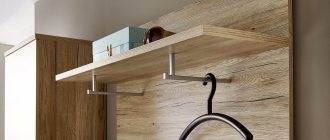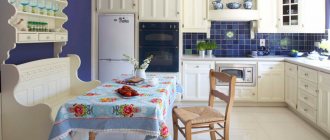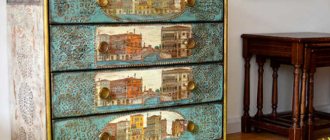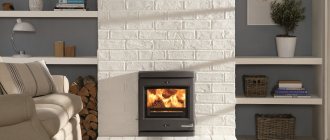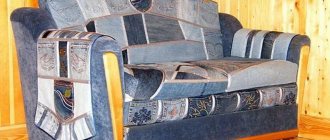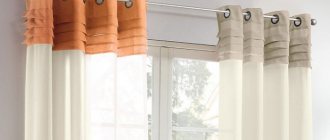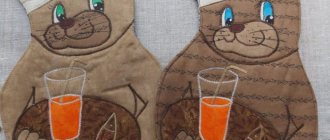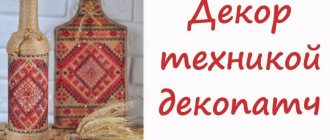The use of mirror mosaics in the interior is now very relevant. Such decoration can give the space a truly amazing, magical and mysterious character. The mirror finish of various areas of the room will attract the attention of any visitor, especially when the sparkling pieces sparkle with reflections of light. A room decorated with mirror mosaics will always look formal and solemn. Even small mirror fragments in the decoration of walls or ceilings will add a special “zest” to the interior.
The advantages of this type of tile
If you look at the photos of various bathroom design options, you can note that in almost 60% of cases the owners prefer this particular type of tile.
Mosaic can easily withstand high humidity without losing strength and reliability even over time. It is used not only for finishing walls, ceilings or floors. With its help you can decorate the smallest decorative elements, it looks quite appropriate and attractive.
The huge color range is complemented by the different materials from which the tiles are made, only expanding the already large selection of products.Round mirrors in minimalist style
“In a dream I saw eternity as if it were a ring of endless pure light, As calm as it was bright”
(Henry Waugh, “The World”)
In the photo: the Cattelan Italia Wish is available in 4 sizes.
In the photo: a round wall mirror without a frame Connubia Lune with a faint pattern.
Pictured: Sovet Italia Visual with lacquered metal frame and polished brass or mocha finish. The mirror is available in various shades: silver, pink, bronze, smoky, gold. Available in four sizes.
Pictured: Baxter Kiko in a modern style with a silver border.
In the photo: large round mirror Meridiani Birk . Wooden frame upholstered in leather.
Porada Giove floor mirror made of solid canaletto walnut.
In the photo: wall mirror in a deep frame Sovet Italia Horizon . The frame is available in two depths and four lacquered finishes (coffee, clay, white and black), which can be combined with mirrors in silver, matt or bronze finish.
Pictured: an elegant round mirror designed for use in the bathroom, Birex Rotondo . Available in several sizes. Can be equipped with a lighting system. Birex Drop mirror is available in 4 drop-shaped sizes.
Disadvantages of using mosaic tiles for the bathroom
The biggest, and perhaps the only negative, is the cost of installation work. Due to the complexity of laying such tiles, the work of craftsmen is expensive.
Even if the owners have purchased inexpensive mosaics for the bathroom, they will have to spend money on a specialist whose services are not cheap. The price of bathroom tiles can be low if you choose a plain and common material. But the more complex the design and the more refined the material, the higher the price.
Main characteristics of such tiles
The main difference is the shape of the product. Most often, square, diamond-shaped, round, polyhedral and rectangular tile shapes are presented in stores. It is less common to find tiles of irregular shape, as they are most often made to order. In the vast majority of interiors you can find rectangular and square shapes of mosaic tiles.
In addition to shape, products also differ in size. The most popular choice is 2x2 centimeters. Tiles can also be sold separately, when the master lays out the mosaic one tiny tile at a time, creating a design or pattern.
There is a cheaper option - this is a base on which the tiles are already attached. This type of base is easier and faster to glue, which greatly speeds up the time spent on exterior finishing of the bathroom.
10.Beads and shells
Frame in nautical style.
Combining beads and shells in the decor of a mirror creates an unforgettable effect. This interior detail will look harmonious in the room of a beautiful lady of any age.
Exclusive DIY mirror decor.
Mosaic tile material
The main types are made of ceramics, smalt or glass. Also, mosaic tiles can be made of wood or other non-standard materials for tiles. But for this you will need to place a special order, since such products are most often not represented in the general assortment of goods.
Where to buy mosaic tiles for a bathroom of non-standard size, shape or material? To do this, you may need to contact interior designers or a tile installer. Because not all stores accept orders for the production of non-standard types of tiles.
How to make it yourself
If there is an unfilled area of any surface in your home, try to revive it yourself with a mirror mosaic made by yourself. You can involve the whole family, especially children, in this exciting process.
To do this, you will need an old mirror, which must be cut into pieces using a glass cutter. These can be fragments of different sizes and shapes - a matter of your taste and your imagination. The main thing is to fold them correctly to create a beautiful ornament.
Each piece should be sanded with an emery block. Sand the corners especially carefully so as not to injure yourself during the work. The result should be a lot of mirrored pieces with dull edges. To glue a homemade mosaic you will need several different tools:
- PVA glue or “liquid nails”. The latter are better, because they will not let it break;
- putty;
- plasticine.
In addition, you will need latex putty, a silicone tube with a tip, and a gun for squeezing the composition out of the tube.
How to glue on the wall
If you simply coat the fragment with PVA glue and attach it to the surface, it will not stick. Therefore, we do this: put a piece of plasticine or putty on the back side of the mirror chip, press it down and make a recess into which we add a drop of glue. Press the piece to the surface. While the plasticine holds the mirror, the glue has time to dry. You need to try not to get any excess on the mirror, otherwise its reflective layer will be damaged.
After laying out the mosaic pattern over the entire surface, wait a day or two for the glue to dry completely. Then start grouting the joints. This procedure is performed using putty. If the mirror pieces are of the same shape, then grouting can be done using a small rubber spatula. Otherwise, use an empty silicone tube, which is filled with putty. It is better to squeeze out the composition with a special gun. But if you don’t have one, then the handle of a regular hammer will do.
Finally, remove excess putty with your index finger. When everything is dry, wipe the mosaic with a damp sponge and then with a wad of regular newspaper.
A composition made of a mirror mosaic can be decorated with additional elements: beads, beads, sparkles, etc. They just need to be pressed into the putty that has not yet cooled down.
Mirror mosaic can be easily dismantled if necessary. Moreover, the pieces can be reused.
Country style house.
Read this article on how to paint plasterboard walls.
Types of putties: https://trendsdesign.ru/materialy/shpaklevka/osobennosti-shpatlevaniya.html
Features of ceramic mosaic tiles
Most often it is made in two types - glossy and matte. Glossy is perfect for any type of surface, be it a ceiling or walls. But it is best to lay matte floors - it reduces the risk of slipping on wet tiles.
Matte mosaics are also used to make decorations or designs on a glossy canvas. This solution looks interesting and non-standard. Ceramics are resistant to temperature changes, fireproof and do not require special care.
Types of decoration
Today, manufacturers offer both a mosaic of white mirrors and tinted tiles with gold, silver, bronze and black shades. The surprising thing is that seemingly fragile-looking mirror plates 5 mm thick are quite difficult to damage. Durability and strength are the main advantages of the material. In addition, mirror mosaic is not afraid of temperature and chemical influences.
Mirror pieces can be different in shape, size, color, type of processing and method of attachment. Depending on the decoration technique, the designer can choose a material in which the fragments will be the same or different in shape and size.
You can buy mosaics ready-made, that is, attached to a grid. Another alternative is to purchase loose material to apply each piece separately to the prepared surface.
The type of processing of the edges of the pieces plays an important role. Mirror mosaic with a matte polished surface is usually used in budget collections. But tiles with polished edges look more stylish and elegant. Another option for processing the edges of mirror pieces is bevelling. Bevel technology allows you to give the tiles additional volume, due to which the mosaic looks advantageous on the surfaces of any room, as well as when decorating furniture. The thickness and size of each fragment can be different, and the choice is determined by the design method and the nature of the mosaic composition.
For rooms with high levels of humidity (kitchen, bathroom), which will require cleaning the tiles with chemical detergents, it is necessary to select a mirror coating with an additional protective layer. Such protection will help prevent darkening of the mirror surface, and the mosaic will last for quite a long time.
The surface lined with miniature mirrors does not require special care. Mirror tiles do not get very dirty and are easy to clean. It is resistant to abrasion, retains the shine of the polished surface for a long time, does not fade or fade over time.
In ordinary rooms with normal humidity levels, there is no need to purchase tiles with a protective layer. Here, a regular coating will retain its properties for a long time.
Features of glass mosaic tiles
Despite the persistent stereotype, glass mosaic tiles in the bathroom are much more durable than ceramic ones. This feature lies in the manufacturing technology, where the glass composition includes feldspar, quartz and dye, which is made from metal oxide.
In addition, during production, such tiles are fired, which hardens the product from impacts. It can also be glossy or matte.
- White tiles in the bathroom: optimal design ideas and combination options. Advice from professionals on choosing tiles and their use (110 photos)
Mirror ceiling in the bathroom - 95 photos and videos of the best ideas for placing mirror surfaces
Bathroom tiles in Leroy Merlin: ceramic options, application features and tips for decorating a bathroom
The main distinguishing property of glass mosaics is their resistance to the development of fungus and bacterial colonies, which is simply ideal for the bathroom.
Decorative elements in the bathroom interior
The following tips will help you create a decorative design for your bathroom using mosaics:
- A spectacular interior decoration is a mosaic panel, painting or fresco covering the entire wall. The opposite and adjacent sides should be decorated with small individual elements of the main image.
Important! It is not advisable to decorate a room with designs that differ in content and color palette.
- The subjects of the painting should be chosen in accordance with the overall interior design idea. For a bathroom in a classic style, large flowers or pastoral scenes with shepherdesses and sheep are suitable, in the African style - savannas with grazing giraffes, elephants and antelopes, in the Mediterranean - the sea, rocks, ships, in Japanese - sakura branches, bamboo thickets, Fuji.
You should not try to create an artistic composition from tiles of different colors yourself; it is better to buy a ready-made set for panels at a construction market or in an online store.
- If the bathroom interior contains potted indoor plants with large leaves, decorating the wall with a bright picture will be unnecessary.
Features of smalt mosaic tiles
Produced in a special way. The tile compound is pressed and fused into small pieces, to which colored glass is added during the press. This technology is used to emphasize one of the characteristics of the tile.
The mosaic looks different at different lighting angles. This is especially achieved due to the fused glass, which creates the effect of glowing from within. The price for this type of tile is much higher than that of glass or ceramic mosaic tiles for the bathroom.
Mirror mosaic - a delightful and incomprehensible attraction
“I will put together a mosaic from broken mirrors” - words from the once famous song by Vyacheslav Malezhik. Modern mirror mosaic LIYA Mosaic is, of course, not made from broken mirrors. Small chips, which can have a polished or matte surface and various shapes, are glued onto a polymer mesh. This creates an amazing material for the complete transformation of any room: bathroom or shower room, bedroom or living room. Real special effects of a magical illusion can be recreated using mirror modules and rhinestone mosaics in a nightclub, restaurant, bar. Individual interior items look great, decorated with brilliant mirror chips or gold mosaic : columns, arches, partitions, etc.
Features of stone mosaic tiles
The choice of stone is up to the buyer, since mosaics can be made from almost any type of stone. Stone tiles have a sophisticated appearance that can transform any bathroom into a masterpiece.
Often, ready-made stones are artificially aged, polished or ground, creating a unique pattern on the product. These tiles are suitable for any type of room cladding, from floor to ceiling.
Tips for choosing
When choosing a mirror coating, it is worth remembering that laying the mosaic can cause certain difficulties. Especially if you purchase loose tiles rather than mesh mosaics. It is very important to develop a design design in advance. What else is worth considering when choosing mosaic options?
- When purchasing self-adhesive mosaic tiles, the protective layer on the product must be removed immediately before installation.
- To cover semicircular surfaces, choose mosaics with miniature tips. The optimal shape for the pieces is rectangles 1 cm wide. It is better to lay them vertically, then during installation it will be easier to repeat the bends of the base.
- For mirror mosaics, white or graphite grout is ideal.
- If you choose a mosaic to decorate the ceiling, then keep in mind that the mirror elements will cast active reflections on the walls. It is very important not to overload other surfaces with decor.
Features of the base for attaching mosaics
Since the tiles are chosen for a rather damp room, it is important not to make a mistake with the materials. The base can be of three types: paper, mesh and tiles without a base.
- Fashionable bathroom tiles: the best finishing ideas and tips for choosing materials. Review of successful solutions and the most interesting combinations
Plasterboard ceiling in the bathroom - pros, cons, tips for choosing a design and design features (90 photos)
Laminate for the bathroom - installation rules, features of ideas for beautiful design and application (95 photos)
The mesh base is placed on the back of the tile, which will be adjacent to the wall. But the paper base is located on the front side of the mosaic - after laying the tiles you will need to remove all the paper covering.
Both the first and second methods speed up the finishing process - the tiles are laid in blocks. If you use tiles without a base, the finishing process is not only lengthened. To do this, you should definitely find a specialist who knows and can work with such details.
Most often, tiles without a base are used for decorative elements in small areas to create a spectacular panel.
Mirror installation
Photo 13: Apply glue
Cut strips of wood the same height as the tiles and glue them to the base. Then apply mirror glue to them. You will also need to apply glue along the inner edge of the mosaic frame - a thin strip so that it does not squeeze out beyond the edge of the mirror.
Photo 14: Install the mirror
We moved the mirror a little so that the glue spread across the base, and then pressed it tightly. After this, we left the entire structure alone for a whole day before attaching the metal parts.
Photo 15: Mark the outline of the mirror on the wall
Measure from the edge of the frame to the screws to determine where to place the two mirror hangers. This ensures that both gimbals fit perfectly into the mounts. However, it is better to use heavy-duty anchor bolts.
Photo 16: cut out recesses for hangers
This step is optional. It allows you to firmly attach the mirror to the wall. If you don't mind a little gap between the mirror and the wall, you can skip this step.
Photo 17: Attach the hangers
To avoid a trip to the hardware store, we made our own aluminum hangers with holes for countersunk screws.
Then we screwed them to the mirror with 12mm self-tapping screws. The last step is to install the structure on the wall. To do this you will need two 50mm screws. To glue the mirror to the MDF base, use special mirror glue (available in hardware stores or DIY supermarkets). Carefully place the mirror in place and then leave the entire structure overnight.
After the glue has dried, turn the mirror over and mark the position of the hangers on the back side in its upper part. If possible, match these marks to the position of the screws on the wall, but if the wall thickness is not suitable for you, use heavy-duty drywall anchor bolts.
Make slits to a depth equal to the thickness of the suspension strip. Screw the hangers to the MDF base and then hang the mirror on the wall.
Mirror framed with glass mosaic
Photo of mosaic tiles for the bathroom
Plastic ceiling in the bathroom: installation instructions and recommendations for choosing a design (95 photos)- Layout of tiles in the bathroom: basic design methods, selection of design, patterns and methods of placing tiles (80 photos)
Wooden floor in the bathroom - selection of the best materials and tips on choosing a installation method (95 photos)
